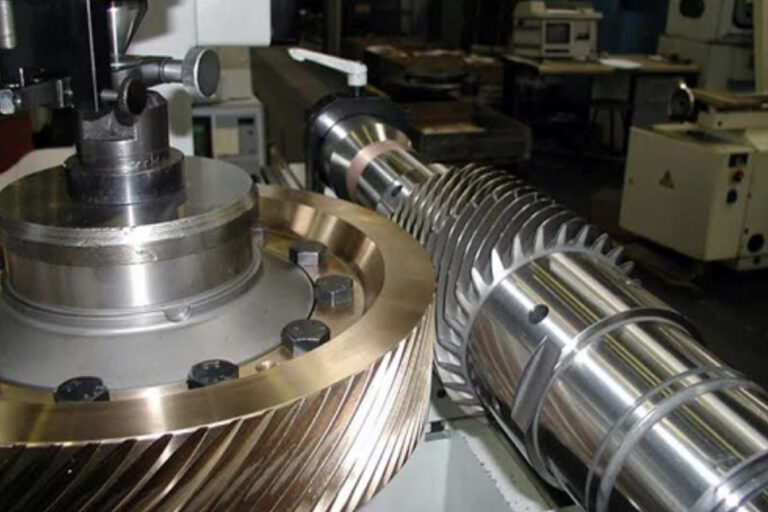
Reverse Engineer Prints Available
SOLUTION GEAR COMPANY 24 Hour Crash Emergency services available. 713-270-6000










Gear cutting is the process of creating a gear. The most common processes include hobbing, broaching, and machining; other processes include shaping, forging, extruding, casting, and powder coating and heat treating, flame hardening carburizing and lapping.
Broaching
For very large gears or splines, a vertical broach is used. It consists of a vertical rail that carries a single tooth cutter formed to create the tooth shape. A rotary table and a Y axis are the customary axes available.
Some machines will cut to a depth on the Y axis and index the rotary table automatically. The largest gears are produced on these machines.

Other operations such as broaching work particularly well for cutting teeth on the inside. The downside to this is that it is expensive and different broaches are required to make different sized gears. Therefore it is mostly used in very high production runs.
Hobbing
Hobbing is a method by which a hob is used to cut teeth into a blank. The cutter and gear blank are rotated at the same time to transfer the profile of the hob onto the gear blank. The hob must make one revolution to create each tooth of the gear. Used very often for all sizes of production runs, but works best for medium to high.
Machining
Gears are cut or ground on a milling machine and gear cutter utilizing a numbered gear cutter, and any indexing head or rotary table. The number of the gear cutter is determined by the tooth count of the gear to be cut.
To machine a helical gear on a manual machine, a true indexing fixture must be used. Indexing fixtures can disengage the drive worm, and be attached via an external gear train to the machine table’s handle (like a power feed). It then operates similarly to a carriage on a lathe. As the table moves on the X axis, the fixture will rotate in a fixed ratio with the table. The indexing fixture itself receives its name from the original purpose of the tool: moving the table in precise, fixed increments. If the indexing worm is not disengaged from the table, one can move the table in a highly controlled fashion via the indexing plate to produce linear movement of great precision (such as a Vernier scale).
There are a few different types of gear hobs and cutters used when creating gears. One is a rack shaper. These are straight and move in a direction tangent to the gear, while the gear is fixed. They have six to twelve teeth and eventually have to be moved back to the starting point to begin another cut. Some other types of gear hobs we utilize are; helical cutting, planetary gear cutting, herringbone gear cutting, spiral bevel gear cutting, straight tooth gear cutting and spline cutting.
A popular way to build gears is by form cutting. This is done by taking a blank gear and rotating a cutter, with the desired tooth pattern, around its periphery. This ensures that the gear will fit when the operation is finished.
Shaping
The old method of gear cutting is mounting a gear blank in a shaper and using a tool shaped in the profile of the tooth to be cut. This method also works for cutting internal splines.
Another is a pinion-shaped cutter that is used in a gear shaper machine. It is basically when a cutter that looks similar to a gear cuts a gear blank. The cutter and the blank must have a rotating axis parallel to each other. This process works well for low and high speed gears.
Finishing
After being cut the gear can be finished by shaving, burnishing, grinding, honing or lapping. With this method of refinishing, we can also leave a high mirror finish or a reground finish and get gears within “0” tolerance.
Grinding
Grinding is a process of finishing the surface of tool so as to make it use for various operations. Abrasive materials are used for grinding a gear when it needs to be ground and carburized, such as surface grinding, lapping grinding, internal and external grinding, blanch grinding and all other types of grinding.
There is no need for your company to go back to OEM and pay 100% of the purchase price when we can rebuild and recondition this equipment. We are looking forward to hearing from you.
Emergency Gearbox replacement 713-270-6000
Shop@sgear.com
